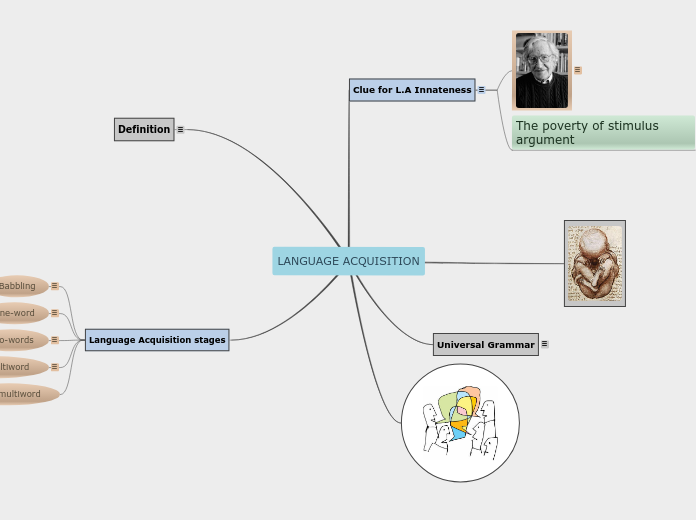da Tiffany Hernandez mancano 6 anni
1419
LANGUAGE ACQUISITION

da Tiffany Hernandez mancano 6 anni
1419

Più simili a questo
Age: 24 to 30 month
Patterns: this is the early multi word stage
E.g. No eat, no porta bien
Age: 18 to 24 month
Patterns: This is the two-word stage.
agent + action (mama sleep, dada work)
action + thing(kick ball,
action + location (sit couch)
thing + location (kitty bed)
possessor + possession (dada boat)
thing + attribute (mama big)
determiner+thing (my sock)
Age: 9 to 18 month
Patterns: This is the one-word stage.
Age: 4 to 8 months.
Patterns:
1. Babies in the babbling stage to produce the same consonant no matter what language they are exposed to:
/p.b,t,m,d,n,k,g,s,h,w,j/
2.Babies produce consonant- vowel patterns: ma ma ma, pa pa pa, da da da, ba ba ba.
Language Acquisition is the unconscious process by which humans develop language without instruction.
Universal grammar is the set of grammatical rules and principles common to all languages.
Clues of universal grammar are the overgeneralizing rules explained before, the fact that children do not learn by imitation or through correction, since they are able to produce words and sentences they have not hear before.
Noam Chomsky was first to argue that first language acquisition in human infants proceeds the way it does because we are cognitive predisposed to acquire language.
Some clues of language innateness are the overgeneralizing rules that children apply to form past tense verb and plurals>
E.g. goed bringed/ mouses foot/ deciba instead of decia (spanish)
According to Chomsky, the input available to children does not provide enough information alone for the child to learn the complex set of grammatical ruler to produce and understand a language.
This is called the poverty of stimulus argument and supports the idea of language innateness and universal grammar.
Avram Noam Chomsky is an American linguist, philosopher, political scientist and activist. He is emeritus professor of linguistics at the Massachusetts Institute of Technology and one of the most prominent figures of linguistics of the twentieth century, thanks to his work in linguistic theory and cognitive science.